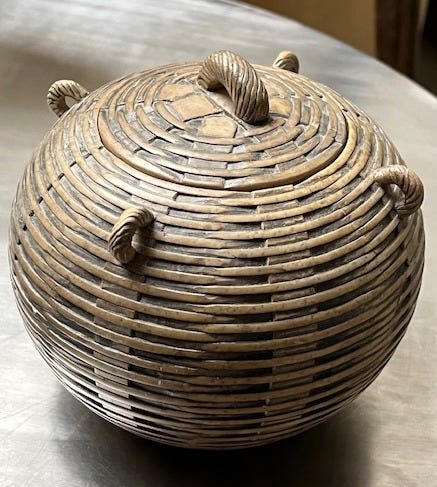Looking Inward
How turning attention to your ongoing thoughts and feelings can deepen your writing and your self-understanding.
To Our Readers:
As we move away from a focus on Elizabeth’s narrative, we find that we need more time to process and investigate the ideas we’re writing about. Our solution, for the moment, is to post every other week. So here is our first bi-weekly post.
We also want to thank you all for following our newsletter. Your feedback is always valuable. Please continue to send us your comments, share your experiences, tell us what you disagree with, and use the share icon to pass “Two Friends Talk About Writing and the Brain” to other readers.
Elizabeth: Last week we talked about how different from one another our inner visual lives are and how much people can learn by looking inward at how their own minds work. Let’s expand on that theme today and focus on how this process can be helpful to people engaged in creative pursuits like writing.
Barbara: In other words, let’s dig into the importance of turning attention to the content of your thoughts and to your feeling-state. This topic relates to the “hot topic” of mindfulness meditation.
Elizabeth: I have to say, the whole idea of meditation never appealed to me.
Barbara: You and I were children of the 60’s “counterculture” that upended the staid 50s. That included experimenting with LSD, marijuana, and mind-altering mushrooms, which paved the way for Eastern ideas to take hold in the West. Part of this was the emerging popularity of meditation in an effort to expand one's mind beyond what we’d thought minds were capable of.
Elizabeth: To me, it all seemed “woo-woo.”
Barbara: Well, initially, this “mind expanding” wasn’t taken seriously in the world of science, either. Eastern ideas were seen as belonging solely to mysticism and religion. I remember hearing Herbert Benson, a Boston cardiologist, give a talk about his research on stress reduction through the use of meditation and breathing techniques. He said that his ideas about mind and body were once so taboo that he had to sneak his subjects into the hospital lab at night to do his research.
Eventually, though, pioneers like Jon Kabat-Zinn started Zen-styled meditation groups for patients. The idea was to be present, to focus on one’s inner experience, to be mindful. And this methodology turned out to be effective at reducing stress, pain, and other symptoms. Today, mindfulness meditation is pretty much fully accepted within the world of medicine and is prescribed by clinicians. And, by the way, one-time use of psychedelic drugs such as psilocybin under guided therapy is also now becoming an accepted treatment for major depression, post-traumatic stress disorder, and more.
Elizabeth: So, the skeptic here asks, how do such approaches work?
Barbara: Well, there has been an enormous amount of research in this area. What seems clear is that meditative practice actually reorganizes neuronal connections in the brain. And even one treatment with “magic mushrooms” facilitates neuroplasticity, the reorganization of neuronal connections in the brain.
Elizabeth: Let’s get to the relevance of mindfulness for writers or other creative individuals.
Barbara: Well, these meditative practices provide the ideal conditions for allowing thoughts, feelings, and sensations to emerge into your consciousness without censorship. And I would argue that neural reorganization in this mental state may lead to the emergence of new ideas, new conceptualizations, new perspectives, new associations. That’s what creativity is!
When practicing mindfulness meditation, one observes oneself intently and then just lets the thoughts and feelings go; but mindfulness techniques can be used for another purpose. That is … the observations one makes, the flow and sequence of inner experience, can be valuable information to expand and deepen understanding for writers or others.
For example, as a physician, during an initial evaluation with a patient, I might momentarily turn my thoughts inward and realize that I’m feeling frustrated in getting the information I need in order to figure out the source of the patient’s difficulties. So I consciously ask myself why the interview is frustrating me. Is the patient providing too many unimportant details, or being vague and foggy about the symptoms, or talking so fast that I can’t ask my questions? These are each clues to a variety of different diagnoses. And, interestingly, when I recognize that the patient’s behavior is a symptom of their underlying problem, my frustration disappears.
Elizabeth: The distinction between letting go of emerging thoughts in meditation versus using them in writing is really helpful! Last week, when I described focusing on a visual image to get under the surface of an experience in writing, the word ‘meditating’ actually came to mind. But I didn’t use it. First, because of my skepticism, but also because I’d thought the goal of meditating was to free yourself of thoughts — the exact opposite of my purposeful “digging.”
Barbara: The point for us is that if you examine your own mind … It’s like free-associating in psychoanalysis. You observe your feeling-state, the tension in your body, your fantasies, flickering associations, whatever; all of this is information about not only yourself but your responses to the situation you’re in or event you just witnessed or are writing about. And you can learn to do this and get better at it with experience.
Elizabeth: I think writers do this to some degree all the time. We constantly go back and forth between actively writing and then reflecting on what we’ve written. When I’m reading my own words, the most common “alert” I get is a sense that something is missing, that there is more: more complexity, more subtext, more meaning. And when I dig, there always is more. The point is to take your intuition seriously and to follow up on it.
The digging feels like a mental journey, which it may be. I focus on a scene, put everything else out of my mind, and imaginatively go back to that place and moment. It’s like time travel. And then the feelings come back, the feelings I had when the scene was happening.
Barbara: It seems you’ve discovered a way to meditate — in spite of yourself! — as part of your writing process.
Elizabeth: I guess so. Actually, I only became aware I was using “mindfulness” — although I had no name for it — when I started posting on Instagram. I’m an addictive collector of all kinds of things, most of which bring to mind a personal story. Instagram was a nice vehicle for relating these little stories. I would start with a photo of the object and write about the connected memories.
Barbara: So in order to write the stories, you first clear your mind and focus on the object, which brings the memory. And then you notice and analyze what rises to the top of your mind?
Elizabeth: Right. And almost every time, the process results in a significant discovery. Take for example a stone pot I’ve had for 20 years that’s carved to look like a woven basket. I noticed it on a family trip but didn’t want to buy it because it’s fragile, heavy, and was made for tourists. I’ve always associated it with the sweetness of my college-aged kids’ pushing me to buy it and then taking turns carrying it home. But when I focused on the pot in order to write the post, I found myself recalling the subtle loneliness of motherhood, of being only visible to my children as “mother” when they were growing up, and then the sadness of their teen-aged pulling away and my fear of losing them. Their picking up on my genuine wish for the pot was the moment I recognized that they saw and loved me as a person, not just in my role as their parent.
Barbara: You get to something deeply emotional and relational … and powerful.
Elizabeth: That’s how it works.







